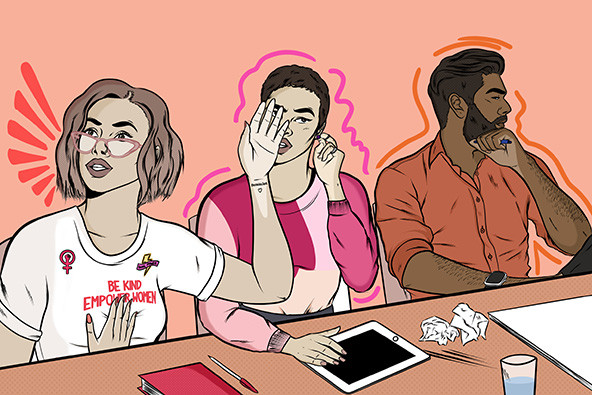 (Illustration by Nyanza D)
(Illustration by Nyanza D)
About a year ago, I sat in a corner of a conference room for a staff meeting at the health nonprofit organization where I then worked. There was nothing in the air to suggest this would be the tipping point for me—we had spent two hours discussing legislative and regulatory happenings, asking if any state partners needed assistance, with staff offering to email so-and-so to navigate the latest federal bureaucratic impasse. I was, as usual, quiet.
While the meetings usually started to wind down with the introduction of status updates about research and reports, the conversation took a turn when senior staff broached the possibility of a new report on policy recommendations for Black maternal health. This topic area wasn’t entirely new to the organization, but funders were specifically requesting more content on the connections between race and health equity.

My eyes were fixed on my notes, but my ears were alive. For 10 minutes the team brainstormed potential coauthors, themes, and lead writers without a single mention of Black women.
“What about partnering with Black-led organizations?” I asked, speaking up amid the chatter. “I think it’s important we don’t do things for communities without community involvement.”
My colleagues became silent, perhaps from the shock of hearing me speak. A room of white faces turned to the white executive director for a response. She considered her words for a moment before answering. “No, I don’t think so,” she said. An opportunity to collaborate with the very people we were talking and planning to write about fizzled like a slowly deflating balloon.
I wasn’t surprised. I had come to expect this behavior in the social sector, particularly among white-led organizations. But the truth of this experience remains that social sector leaders who “speak for” marginalized groups, instead of actively including them in vital policy, advocacy, and service work, engage in harmful behavior that excludes marginalized communities from making decisions that affect their lives. No diversity, equity, and inclusion training can solve this problem without addressing its root cause.
Communities Rely on Nonprofits
I am a biracial woman and second-generation immigrant. Like many people of color who are drawn to the nonprofit sector, I was inspired by the idea of helping to solve the world’s most complex and deeply rooted injustices while advocating on behalf of my own communities. And, with more than 1.5 million nonprofit organizations registered with the Internal Revenue Service in 2016 (and 32.5 percent of them being human services-oriented organizations), I found plenty of opportunities to get involved.
Nonprofit organizations fill large gaps in services that may not otherwise be provided by the federal government. Take a look around your own community and chances are that local places of worship, cultural centers, farmers markets, health clinics, homeless shelters, job training programs, and more are run through nonprofits. Given the stakes that many marginalized communities have in these services, I naively thought that direct stakeholder engagement in decisions affecting communities would be routine. It was not.
In some regard, there is an established logic at work based on the seriousness and immediacy of the problems that nonprofits tackle. So, if there is pre-existing literature or research that suggests a particular intervention will help a mother have a healthy pregnancy, for example, then setting that intervention in motion—through direct services or policy recommendations—is the obvious choice.
But obvious for whom?
White Supremacy Culture Roadblocks Justice
Community engagement has not been the standard order of operations in white-led nonprofit organizations. Good intentions aside, it is easy for people who control the power and resources to slip into mindsets of “we have what you need, so we’ll make the choices for you.” To call it a shame would be putting it lightly, since the services, advocacy, and policy levers that white-led nonprofit organizations champion as “the” solutions can maintain status quo incrementalism without addressing root inequities. As environmental advocates Robert Garcia and Marianne Engelman Lado wrote in the National Recreation and Park Association’s Open Space blog, “A thoughtless policy can be as unfair as, and functionally equivalent to, intentional discrimination.”
However, community engagement as a framework to guide action and even research toward the greater goal of informing inclusive decision-making practices is not new. A wide breadth of literature and toolkits demonstrate the value of these practices. They offer a democratic model of knowledge production that centers stakeholders and communities members rather than funders, academics, or white-led nonprofit organizations. In doing so, these approaches can instill greater trust in both decision makers and the decision-making process. By including and centering communities, we acknowledge that the very people who are affected by decisions—be they Black mothers or Asian immigrants or folks with disabilities or transgender people or low-wage workers—can be better at problem-solving than a small group of white experts. All of this is known. The problem is not a lack of knowledge or frameworks or action steps to center communities. The problem is that (white) nonprofit leaders, even those who profess that participation and inclusion as crucial drivers of social justice and equity, usually seem more comfortable speaking for marginalized communities while—intentionally or unintentionally—excluding their expertise and perspectives from service, advocacy, and policy work.
These tendencies stem from a deeply entrenched culture of white supremacy and accompanying racism and paternalism that inevitably appear when white leaders hold resources and power over communities affected by historical, social, and economic disenfranchisement. When I meet up with nonprofit colleagues-turned-friends, we often discuss white saviorism in the sector. Our conversations oscillate from comparatively mundane episodes to outright racist behavior, such as a former nonprofit president I worked for demanding that an illustrated Black woman in a patient education video have dreadlocks and speak Ebonics.
From these reflections, a devastating realization has dawned on me: Perhaps if white leaders in nonprofit organizations did not have the final say in important decisions, if decision makers were representative of the wider communities affected by any particular injustice, or if they actually believed that communities did have the solutions to their own problems and didn’t need another report, the exclusion and racism at work at such nonprofits wouldn’t exist.
Ultimately, through bypassing marginalized communities and excluding them from having a voice in choices that affect their lives, (white) nonprofit leaders silence them and further consolidate their power. Superficial solutions and cautious incrementalism aren’t designed to liberate the underprivileged; they’re designed to maintain those in power by withholding funds and resources just enough to sustain white-led organizations at the expense of actual justice. None of the diversity and inclusion trainings I have sat through come close to acknowledging this, and I suppose the truth can feel shocking when white audiences and leaders aren’t coddled to.
Listen With Your Ears
Social sector leader and critic Vu Le shared the following exchange in a story he wrote for his Nonprofit AF blog: “Over a year, we asked a whole bunch of organizations led by communities of color what they need in order to grow their capacity. We had interviews and focus groups. What they all wanted was staffing. They need people. … That’s what the communities want! Why are you trying to find a model when we already have a strong model to test out?” (emphasis added). His comments reminded me that exclusion is not accidental: White leaders are given the answers, but choose not to listen.
“Look with your eyes, not your mouth” my mom and many of my titas repeatedly told me. It is a Filipino proverb that essentially means you won’t find what you’re looking for if you’re using the wrong tools. When it comes to white-led nonprofits not listening to communities, I offer this version: “Listen with your ears, not with your eyes.” The eyes are a filter that prejudices our perception of people who do not look like us or do not have the same economic, social, and cultural privileges that we do.
The meeting that discussed Black maternal health happened more than a year ago, and the organization ultimately decided to drop the project. To me, this result was a double travesty. I wish I was more surprised that given the choice between not being able to center themselves and the reputation of the organization versus approaching the critically important work in a community-centered and inclusive way, the solution was just not to do anything. Yes, the decision was made in self-interest. Yes, they were unwilling to approach the critically important work in a community-centered and inclusive way. Yes, they favored centering themselves and the reputation of their organization over finding solutions. But the decision was also made in the context of a nonprofit landscape where organizations led by people of color are less funded and less trusted to make decisions about how to spend funds than white-led organizations. The choice not to include communities in decision-making also meant that resource- and knowledge-sharing stopped in that room.
White-led nonprofit organizations must include communities in decision-making processes that will affect their lives. Satisfying this imperative will require enormous behavior change and massive rethinking. It demands that white-led organizations sacrifice their privilege and maybe even redistribute their resources and enable others to become the heroes. As long as the services, advocacy, and policy levers for eradicating deep inequities originate solely from white experts, they can only be successful in the context of whiteness. It’s hard to imagine a future that is liberatory and equitable if white-led nonprofit organizations only listen with their eyes and fail to hear the people who have the solutions—but not the resources—to solve their own problems.
Support SSIR’s coverage of cross-sector solutions to global challenges.
Help us further the reach of innovative ideas. Donate today.
Read more stories by Kaitlyn Ram Bo.

